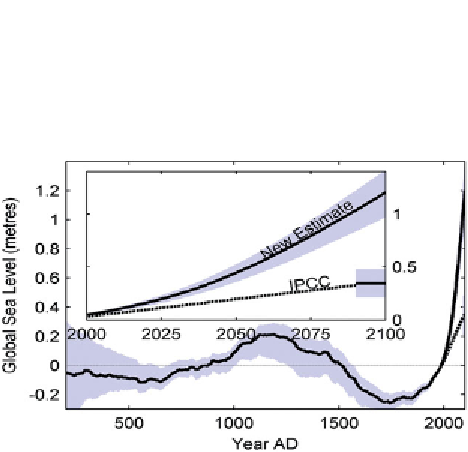Geoscience Reference
In-Depth Information
Figure 11.4
The rise in global mean sea
level over the last 2000 years, with the
projected rise to 2100 inset. The shaded
regions are estimates of the uncertainty.
(Grinsted
et al
., 2009)
increased snow and ice melting, vertical motion of the land locally through tectonic
processes and in higher latitudes isostatic recovery, sometimes called post-glacial
rebound. During the last ice age (about 12 000 years ago) the polar and some mid-
latitude regions were covered with thick ice. The weight of the ice caused the surface
of the Earth
s crust to sink. As glaciers have retreated since the end of the ice age, the
load on the land has diminished and the depressed land is very slowly rising again.
Greenland has lifted by about 70m since the last ice age; rebound rates vary
markedly and are not well determined across Antarctica.
Shorter timescale processes are super-posed on these longer ones. For example,
changes in atmospheric pressure can change local sea level by ~1m, albeit for a
short time (days), seasonal run-off from the land can make changes of a further metre,
and El Niño causes sea-level changes on a timescale of years. The combination of
all these factors means that sea-level rise is not uniform across the world.
The potential impacts of sea-level rise are enormous. Every year about
10 million people are affected by coastal
'
flooding. In the European Union, about
14% of the population (70 million) live within 500m of the coast, and the assets in
this area exceed 1000 billion euros. In addition to coastal
flooding, rising sea level
causes increased rates of coastal erosion, destruction of natural and arti
cial sea
defences and thus additional impacts on humans and their livelihoods. In the
European Union about 3.2 billion euros is spent annual protecting people and
assets from sea-level rise, a sum that will continue to increase through the century.
As sea level continues to rise, and populations increase especially in urban areas,
more and more people and infrastructure will be affected by
flooding and
inundation and thus the social impacts will be far greater. Current estimates of the
impact of a 1-m rise in sea level will affect a few million to a few tens of million
people in most continents. Asia is an exception; over 100million people are likely to
be affected, particularly in the low lying river deltas of the Ganges
Brahmaputra,
Irrawaddy, Chao Phraya, Mekong, Yangtze and the Yellow River. Protection of
-



Search WWH ::

Custom Search